Tachiai: Initial Charge
This time we spotlight tachiai, the initial charge that starts all bouts. It's said that 90% of matches are decided at the faceoff. But there are many factors at play. Do you lead with your right foot or your left? Should you put more emphasis on your first step or your second? And what kind of mind games take place as rikishi go through pre-bout rituals and synchronize their timing? Our guest is Nishonoseki Oyakata, who reflects on his tachiai technique and talks about facing off against fierce rivals.
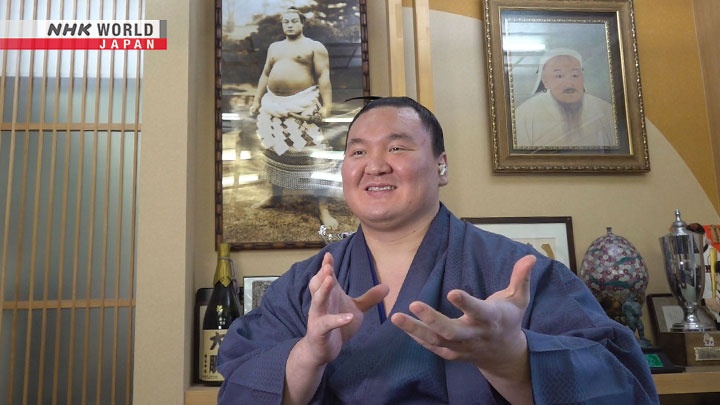
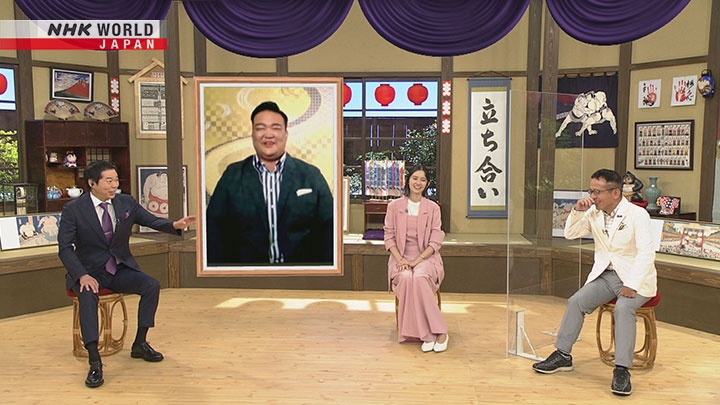
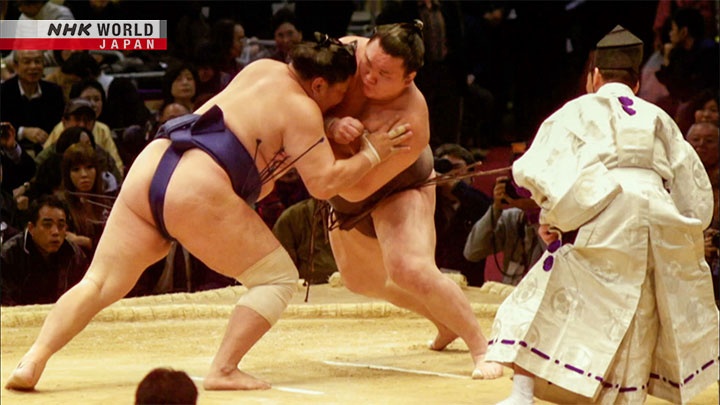
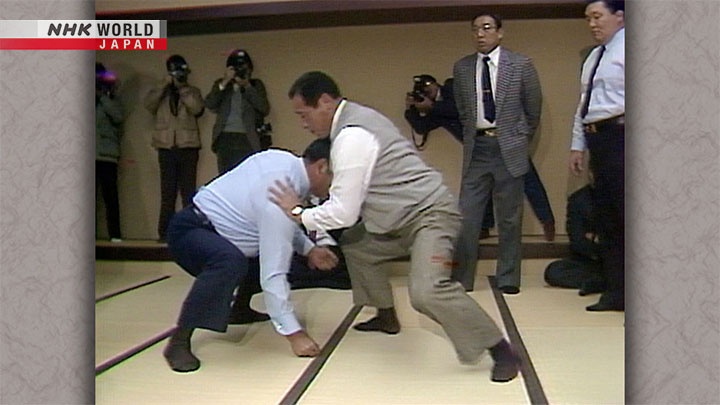
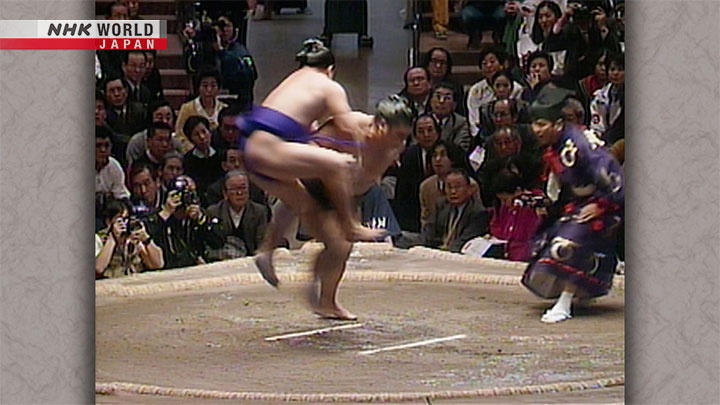
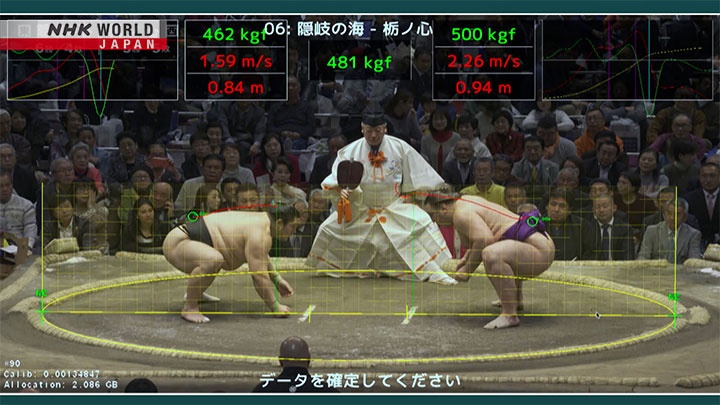
Transcript
DOSUKOI Sumo Salon.
This time: tachiai, the initial charge.
Oof! That's brutal!
Starting just 70 centimeters apart, two 150-kilogram human titans collide at full force.
It's a split-second engagement...
...but it can decide the outcome of a match.
Rikishi give it their all, and it's resulted in many memorable moments.
Good contact.
Yorikiri, Asashio wins!
Asashio is bleeding!
This rikishi says his best tachiai often left him bleeding.
- He was often bloodied.
- Oh wow!
Now Mainoumi, known for his dazzling repertoire of techniques.
Look at him go! I remember this!
What's Ichikawa Saya's tachiai pick?
Day 6 of the 2020 July Tournament, Enho versus Chiyotairyu.
Giant-killer Enho showed great technique in this initial charge.
It's like wrestling!
At first glance it looks like a sidestep, like he's moved around his opponent.
But if you look closely he goes in headfirst and then grabs the mawashi with his left.
Ah, I see.
It's very technical. A tachiai with so much to savor.
We also asked this veteran sumo commentator for his tachiai pick.
For me, this is the ultimate!
Hakuho gets a belt grip in the blink of an eye.
Whoa!
See how he went in low?
It's a risky move - touch the ground and he loses!
Yes, his left hand is inches off the surface.
That's incredible!
Today we use in-depth analysis to unpack the techniques and drama behind these explosive moments.
Stop!
- 8.5 centimeters.
- Got it!
Who comes out top in tachiai speed and force?
And a survey of over 2000 bouts spanning 15 years generates some amazing insights.
It's time for DOSUKOI Sumo Salon!
We begin by welcoming a key member of the team.
- Oyakata!
- Great to see you!
- Welcome!
- Glad to be here.
It's the 72nd Yokozuna Grand Champion, Nishonoseki Oyakata.
So, Oyakata, our topic for today is tachiai.
You know, tachiai is just so interesting,
but the most important thing is seizing the initiative.
Get the jump on your opponent, and you can dictate the pace of the match.
For us commentators, if Kisenosato got a right-hand outside grip from the get-go,
we knew he had a good chance of winning.
If he came out on top in the initial charge, we knew the bout was as good as his.
I was constantly thinking about sumo.
- Even when I was grabbing a bite to eat with someone, I'd try to get in sync with them.
- What?!
You "must" have that mindset.
So during conversation, I'd be thinking in sumo terms about seizing the initiative.
In the middle of a meal?
Even when you say "Cheers!" That's tachiai.
Tachiai is all around us!
It's everywhere!
How important is it to seize the advantage in the tachiai?
We consulted Professor Kuwamori Masasuke, a leading sumo researcher.
Half a second into the initial charge, the video stops.
Who's on top?
That's all he gets to see?!
Then we checked to see if that rikishi ended up winning.
Let's start with this bout.
I give this one to Kotoshogiku.
Chiyomaru has yet to take a step forward, although he's leaning in.
Kotoshogiku's on the front foot.
That's good.
And the result?
He had a strong initial charge and from there it was pretty much over.
Next...
This is a tough one.
Unusual from Tochinoshin.
But I like that positive sidestep to the right.
Kagayaki is simply charging straight ahead.
And the result?
Yet again, the rikishi with the advantage wins the match.
Imada-san, care to guess the next one?
Let's do it! In my head I'm already 2 for 2!
OK, then. Here we go!
Whoa! Tricky... but I'd say Meisei.
Terutsuyoshi's trying to evade, but he's facing downward.
He's going to get pushed out.
And what does the professor say?
Terutsuyoshi's trying something unusual here, and it's working.
He makes his opponent think he's coming at him,
but he lowers his head and at the same time moves right.
Who will win?
I was "way" off!
That one was tough!
We checked the 100 top-division bouts from the last five days of the 2020 March Tournament.
Wow, 100 bouts!
In eight cases the two rikishi were found to be on equal footing.
But in the 92 other bouts, 58 were won by the rikishi with the initial advantage - a 63% win rate!
What do you think, Oyakata?
- Hmm... well, it feels like the number should be even higher.
- Right.
I think 90 percent of bouts are decided at the tachiai.
90?!
So 90 percent rests on the tachiai!
In my case, that's where I focused my attention.
I see. What was the most important thing for you in a tachiai?
One thing is you want to go in headfirst.
- But in my case, if I could, I'd go in "face"-first.
- Face-first?
When you do that, you instinctively end up tucking your head in a bit.
- That was my angle of attack.
- Ah, interesting!
So I went in with my face, then tucked my head, and made good contact.
- I see!
- So I tried to aim for their upper chest with my head.
- That helped me channel my weight and power.
- Fascinating.
The Oyakata says when it comes to throwing your weight into the initial charge, starting posture is key.
It's something he worked on throughout his career.
When he first entered the top four ranks, he kept his head down low and his bottom angled up.
Four years later.
In this bout, he put an end to Hakuho's 63-match winning streak.
Completely different!
He squats down low, and holds his head up.
Six years later, after he was promoted to the second-highest rank of Ozeki, his head and bottom are level.
Look at the difference!
A significant evolution. Oyakata, what's going on?
Wow, I wasn't expecting to see such a clear change.
- It's quite dramatic.
- Yes.
Yes. Back in 2006, my form wasn't even on my mind, I was just focusing on charging hard.
I was all instinct in those days.
You were raring to go!
But heading into the November 2010 tournament, I made an effort to change my tachiai posture.
I wanted rock solid lower body stability.
So that's what was on my mind in "that" tournament.
Why did you want to change things up?
I sought out the advice of Japanese martial arts teachers.
They told me I needed a strong central axis and a low center of gravity.
That's the advice I received.
And did you notice a difference in the way you made contact?
The impact was completely different.
It was fascinating how I could feel an opponent crumble in the initial charge.
Crumble! Wow!
What does "that" feel like? A crumbling opponent?
The moment that happens - their sides become vulnerable.
- And that's when I'd go in for my signature left inside grip.
- Interesting!
If I didn't break them with my initial charge,
I'd put extra strain on my elbows and body as I tried to get a grip.
So from 2010 I started changing my approach, and in my Ozeki days I tried leaning forward more.
I'd take videos of myself and try to figure out where I felt the strongest.
I took it tournament by tournament.
You did a lot of experimentation?
I still have all the videos I took on my phone.
They're on your phone?
Wow, trade secrets!
I shot loads of videos.
So many!
We asked the Oyakata to show us his process.
I'd lower my center of gravity and focus on my initial step. I'd plant my foot down.
Ah, I see.
I'd do this over and over before tournaments.
I was trying to get a sense of what my ideal tachiai would look like.
Does planting your foot like that help you absorb your opponent's momentum?
Yes. You choose your spot and stop.
Your opponent comes at you and "wham!"
- Now they're upright, so you can get inside.
- I see.
Maybe it's like a punch, where you keep your fist loose but tighten it at the moment of impact.
It helps to transmit force.
So in tachiai, maybe planting your foot is like tightening your fist.
- Right. You become a huge rock, a boulder.
- That's it!
If you don't have deep stability, you cannot become that rock.
Lower your center of gravity, and your body locks into place.
Did you experiment with variables like standing farther behind the starting line or shifting your position to the side?
Great question! Indeed I did.
In 2006 my hands were in front of me.
I did that for a while, but then I tried bringing my arms in a little closer.
And "that's" when I was able to become a rock.
Ah, I see! You'd think having your arms held out would help you get out of the blocks.
But you should bring your arms in.
Can you harness your power or not?
Just a millimeter difference in how high or low your center of gravity is,
tiny differences like that completely change the amount of force you generate.
So my tachiai form is something I focused on a lot.
I had no idea Kisenosato was putting so much thought into his tachiai.
In retrospect, it's mortifying. I should have realised.
Back in the day, we'd often see him practicing that.
But when we asked him about it, he wouldn't say much.
Maybe he didn't want us to know.
That would be my guess.
Right. I shared nothing in interviews. I didn't want people catching on.
But it was tough! I mean, you know how much I love talking.
Tell me about it! On this show, you're a totally different person!
The key to tachiai varies by rikishi.
But we have a secret weapon! NHK's 8K ultra-high definition TV!
We used it to focus on "three" specific factors.
As a point of reference, we looked at a rikishi's mawashi knot.
We tracked its location thirty times a second and used "that" to quantify the three factors.
Wow!
Its location at the point of impact gives "hip height."
Measuring the distance traveled and dividing that by time gives "speed."
Based on speed and the rikishi's mass, we calculate "Impact Force."
We looked at every top division rikishi in the 2020 January Tournament and ranked them in these three categories.
First, let's look at "hip height." Our number one beat out the Yokozuna and Ozeki.
Enho, who thrills spectators with his unpredictable tachiai.
He ducks right down to evade his opponent's force,
and this makes them lose their footing.
He goes under, dives into their chest, and aims for a belt grip.
It's a strategy that only "he" can pull off.
That's very low!
Among the comedians I know, I'd say Fujii Takashi has the lowest hips.
He keeps his ego way down low.
Next, let's look at speed. Here are numbers 5 through 2.
Coming in at number one...
Yokozuna Hakuho, the rikishi with the most tournament wins in sumo history.
He lunges in and gets a belt grip, forcing his opponent to fight on his terms.
Overwhelming speed...
He could top 2 meters per second.
Let's compare his first step with that of an opponent.
He lunges forward, and gains a dominant position.
His unrivaled speed in the initial charge was one of his biggest strengths.
Incredible!
Back when I was active, I had a chance to compare the tachiai stats of different rikishi.
In terms of speed and hip height I was basically second to last.
- Second to last?
- Yes.
And I still made it to Yokozuna!
Well, you focused on going in facefirst! You were all about impact!
So now let's look at impact force, the key factor for the Oyakata.
But before we unveil No. 1...
Let's hear from this hard-charging rikishi.
Musoyama, who now goes by Fujishima Oyakata.
What are his thoughts on our No. 1?
He goes in head-on and wins.
I think his tachiai are simply beautiful.
Of course, this is a rikishi who won the 2019 May Tournament and made it to Ozeki once.
Fujishima Oyakata has nothing but praise for our No. 1...
Asanoyama!
Asanoyama says he never sidestepped in a tachiai.
He generates a fearsome force in his initial charge.
Asanoyama's initial lunge is incredibly powerful because he's got both feet firmly planted as he charges into his opponent.
Back when I was active, this was my ideal tachiai style, too.
I had the same approach.
Now, then. Here on DOSUKOI we bring you unique takes, and today is no different.
- Next, we look at why tachiai are all about "touch" and "ai."
- I see...
Well, the production team thought it was funny.
OK! Let's watch the following video clip.
We begin with this 1980 bout between Yokozuna Kitanoumi and Kurosegawa.
Will they charge?
- They're staring each other down
- It's a staredown.
This is rare.
They're still staring.
What's going on?
It took a whopping 27 seconds for them to get started.
Yorikiri, frontal force out.
Kitanoumi wins.
Uh, what was going on there?
You don't often see "that."
I don't think I've "ever" seen it.
Isn't the referee supposed to say something?
He can't do that.
A bout can only begin when the rikishi are in sync.
There can't be many sports where the competitors are basically free to decide when to start.
But I see referees shouting things out...
That's only after the match begins.
- Really?
- Yes.
What about "Hakkiyoi"?
It depends on the context.
In amateur sumo, the referee signals the start of the match.
But in Grand Sumo, the referee stands by until the match starts.
The rikishi charge when they are ready.
- In the Kitanoumi-Kurosegawa bout, my take is that Kurosegawa wanted to get Kitanoumi worked up.
- I see.
Kurosegawa wanted Kitanoumi to charge first, but it didn't work out for him.
- Wow.
- Mental games before the fighting starts.
But both rikishi have to be in tune for the tachiai to work.
They're negotiating the terms of battle.
Finally, they see eye to eye. And...
- ...they go for it.
- Yes!
It takes a special connection.
And that's why we're saying tachiai is "touch" ...and "ai." ...I guess.
- Yes, but if the connection is "too" strong, you're vulnerable.
- Right.
You know, I was against this whole "touch-ai" thing when I was being briefed for the show!
Did you know there was a sumo match in the early 20th century where the rikishi shared no chemistry?
Back then there was no time limit on tachiai.
So there "is" one now?
Today in the top division rikishi have four minutes.
But let me take you back to the days when there was no time limit...
It's the 1912 May Tournament, and on Day 3 Tachiyama faced off against Chitosegawa.
Let's see a newspaper clip.
One hour to get underway!
- One hour?
- It took them a whole hour to start.
What were they doing?
Their face-off ended up in false starts over 30 times.
Apparently Chitosegawa wanted to get his opponent riled up.
And there's a quote from Chitosegawa where he says they reset so many times he forgot how tachiai worked.
I bet Tachiyama was livid!
Now you must be wondering who won the bout.
The match itself actually took less than a second.
- Wow.
- Chitosegawa lost in an instant! After all that?
After an hour...
How infuriating!
The rules state that in the top division,
rikishi have four minutes to start the match after being called up to the ring.
During that time, they perform pre-match rituals and try to synchronize their timing.
Pre-bout rituals help rikishi get on the same wavelength.
If you asked them to face off and start immediately, it wouldn't work.
They just have to get into sync.
So they repeat the routine three or four times and gradually sync up.
That's when you get a good tachiai.
To the casual observer, a false start may seem meaningless, but at times, it's necessary.
The Oyakata says sometimes false starts are "inevitable."
There was one opponent he found especially troublesome: Yokozuna Hakuho.
False start.
They're not in sync.
Second attempt.
It's a no-go.
The Yokozuna calls it off.
Whoa!
It's a third false start.
Is Hakuho getting annoyed?
We looked at all 60 bouts fought between Hakuho and Kisenosato, and counted 25 false starts.
- I never associated Kisenosato with false starts.
- No?
This was unexpected.
And it was "only" against Hakuho.
Oyakata, could you explain?
- Well, this just goes to show how good Hakuho's tachiai tactics were.
- Ah!
When it felt like I had the advantage... he'd go for a reset.
If my aim was to have him touch down and charge first, I just couldn't get him to take the bait.
So to be honest, facing off against him hardly ever went my way.
He really knew how to play the tachiai game.
Even before the initial charge, the battle had already begun.
When it came to throwing salt, he'd wait for me to throw first, and then he'd go.
It was all part of his mental game.
That's fascinating.
I'd be determined to wait him out, but it would take forever for him to throw salt.
You both want to be in charge.
When you step into the ring you want to control the flow.
That's right.
I've been wanting to ask... when you charge and it's a false start,
you've just shown your opponent what you were planning to do.
So do you then change your approach?
When you lunge forward you basically give away your game plan. Right.
Well, one time I charged his left side because I wanted a left inside grip. False start.
And now he knows my plan.
So instead I went in headfirst and tried to clamp down with my left.
It's all part of the tachiai game.
We've seen how rikishi sync up in their minds.
That's the "love" angle.
Now let's talk about "touch."
The issue of "touch" came to the forefront in 1984,
when the Japan Sumo Association gathered all top-division rikishi for a special briefing session.
Place your fist on the ground.
The other hand can be a quick touch.
But one fist should be firmly down.
What prompted this training session?
Wow! Legends!
Let's see the style of tachiai common back then.
Eager for a timing advantage, many rikishi were starting from a standing position.
Sumo elders saw that as a problem, and they moved to crack down.
A standing charge looks terrible.
And your muscles aren't ready.
You need to power out of a crouch.
Why were the elders getting so worked up?
The sumo arena Ryogoku Kokugikan opened the following year, 1985.
They wanted it to be a new beginning for Grand Sumo.
And so they held that briefing session to make tachiai "look" better.
Ever since, if rikishi do not touch down with both fists, a re-start can be ordered.
So you have to touch the ground.
It's all about "touch" and "ai."
At least I think that's what they want me to say.
- Imada-san: "Tachiai is touch and ai." Got the meaning now?
- They're losing patience!
You need both a touchdown, and a heart-to-heart connection.
...Does that get me off the hook?!
Yes, tachiai is touch plus ai.
As long as you have both elements, anything goes.
Case in point...
Let's relive some memorable tachiai where rikishi fought outside the box.
Approach number one: straight down to business.
These two rikishi have lots of time left on the clock.
Plenty of time left but
both rikishi are raring to go.
They charge!
Rikishi are free to start at the first face-off.
That being said, hardly any rikishi actually do that.
Takatoriki was known for getting straight down to business.
Even against Yokozuna, his fighting spirit was on full display from the get-go.
They're fired up!
He glares at his opponent, as if to say: "Bring it on!"
Scary!
There's so much time left on the clock that the referee isn't even facing the middle of the ring.
They still have time.
But they charge nonetheless!
When rikishi charge without warning, how do referees cope?
Their eyes tell you when they're ready to charge.
If a rikishi comes to the middle of the ring raring to go, you can sense it, "oh, he's gonna go for it."
But even a top-ranked referree like Ito was caught off-guard by one rikishi.
Just when I thought he was getting out of his crouch, he'd step back,
so I'd think he was signaling a false start.
With that rikishi, I found it very hard to time my shouts.
Approach number two: out of left field.
Let's see that rikishi in action.
He leaped!
...Mainoumi, known for his stunning tactics.
Here's a tachiai that would fluster any referee.
In an unprecedented move, Mainoumi hops back.
Because it looked so much like a false start,
the referee wasn't sure if he should yell out "hakkiyoi."
You caught referees off guard.
Did I?
Catching them off guard.
To be honest I never considered what it was like for referees.
With the initial charge the key for me was not to be driven outside the ring.
If I could prevent that, I had a chance.
Personally it would have been great if there were no tachiai.
I thought a lot about ways I could skip over tachiai and get straight into the match.
That's why I did things like leap over my opponent.
Wow, there really are so many dimensions to the tachiai.
Yes, this one-on-one faceoff is endlessly complex.
All these amazing things are part of Grand Sumo!
Next let's focus on the leading foot.
Earlier, the Oyakata said the first step was key.
But the conventional wisdom in sumo is different.
The initial step should be a half step or less.
The idea is that the first step should be a short one.
That allows you to gather momentum for your second step and make a bigger impact.
In other words, it's all about the second step.
So which is it? The first step? Or the second?
It's time for in-depth analysis!
Oyakata, in terms of tachiai technique, is the first step more important, or the second?
In terms of conventional wisdom... I think many rikishi focus on the second step or the third step.
But I used to put everything into my first step.
- OK... so you take the first step, become a rock, and break your opponent.
- Yes.
Saya, any thoughts?
I've heard something about the two steps idea... It's like getting a running start.
Gives you more momentum.
- One step is a very different strategy.
- Right.
Are rikishi putting more emphasis on their first step, or their second step?
- Stop!
- Stop the video!
Whoa, measuring by hand?
The old-fashioned way!
Our team used 8K footage to measure step length for different rikishi down to the millimeter.
We looked at every first and second step taken by top-division rikishi on Day 14 and 15 of the 2020 January Tournament.
Let's look at the results for these three rikishi.
First up is Tokushoryu, who ended up winning the title.
First step, 24.3 centimeters.
And his second?
It's three times the length of the first.
He did well to manage that!
He used his momentum to power through and win a close contest.
Tsukiotoshi, thrust down.
Tokushoryu wins.
Next up is Takakeisho.
First step, 8.1 centimeters - tiny.
His second... is five times longer.
That suggests he too puts emphasis on his second step.
And lastly, Asanoyama.
First step, 45.9 centimeters.
That's big!
Second step...
37.8 centimeters.
Asanoyama's first step is the big one.
Just like the Oyakata.
He got himself into good shape with his first step, then drove his opponent out of the ring.
Asanoyama with 10 wins!
Our team surveyed 76 rikishi in all.
More rikishi took a larger first step.
But rikishi who took a larger second step had a slightly better win rate.
What does our studio panel think?
I don't know what to make of this. Oyakata, what are your thoughts?
I think it depends on the rikishi's style of sumo.
Asanoyama is a belt-fighter like I was, so his focus is on the first step.
Takakeisho is a pusher-thruster - that's his style.
If he takes a big initial step, there's no room for a second.
So I think the difference in styles is a key factor.
Yes, Asanoyama is similar to you in sumo style.
So for him it's all about the first step.
I think the survey proves my point!
Earlier we saw that Asanoyama's initial charge had the strongest force.
It's all because of the first step.
Great work, research team!
No, no, Oyakata, the pleasure is all ours!
In fact, we looked into another question that should interest you greatly.
Did the Oyakata lead with his left foot or his right?
It must be one or the other.
Let's start by looking at the 2006 July Tournament - Kisenosato's first as Komusubi.
He led with his left.
It turns out that in the 2006 July, September, and November Tournaments, he led with his left nearly every time.
Later he was promoted to Ozeki.
And he began to lead with his right foot.
In fact, for several tournaments he led much more with his right.
He'd gone from leading with his left, to leading with his right.
What was the reason for the switch?
This is something I was very conscious about.
In my early twenties, I'd venture to guess I led with my left 100% of the time.
But I started to feel I was lacking something,
- so I started to explore leading with my right during training, then in matches.
- Wow.
Basically, I led with my left foot when I wanted to stop my opponent in their tracks,
or push and thrust them out of the ring.
And I led with my right when I was going for a left inside grip plus right outside grip.
Is that something most rikishi do? Change up their style, their approach?
Yes, we're constantly thinking about how we can boost our chance of winning.
Right, and so it's good to have various options.
The stats back the Oyakata up.
In the tournament where he won his first title, he switched feet frequently.
He says one tachiai in particular proved to be a major turning point.
It was Day 2, when I faced off against Tamawashi.
I'd beaten him easily many times by stepping in with my right.
But on this occasion, I decided to switch it up and lead with my left.
Tamawashi was on a roll, having beaten a Yokozuna and three Ozeki in the last tournament.
Sensing that leading with his right could be risky, Kisenosato decided to go with his left.
Time's up.
Kisenosato in headfirst!
A dominant performance!
The Oyakata was on the alert for Tamawashi's powerful throat-thrust.
But because he led with his left foot...
...he was able to push back with his left hand and neutralize the thrust.
From there, the match was essentially over.
I won so easily with that approach. That gave me momentum.
I powered through with a 14 and 1 record and became Yokozuna.
So you could say that Day 2 tachiai changed my life.
The fact that I took a chance and chose to go with my left.
So choosing which foot to lead with can be a life-changing decision.
Tachiai really is make or break!
Finally, we asked this legendary rikishi about his thoughts on tachiai.
Ah, Hakuho!
His answer took us by surprise.
During tachiai, I see everything in slow motion.
Slow motion. His perception of time slows down.
What does that mean exactly?
One point, obviously, is that Yokozuna are expected to win.
You need to be able to focus.
And also, in my mind... losing was a form of death.
So maybe... for those few seconds...
my brain was in a different dimension.
What an insight! Oyakata, what do you think?
It really shows that Hakuho was a Yokozuna of the highest caliber.
Seeing things in slow motion...
He was totally in the zone.
Oyakata, do you see things in slow motion?
Me? Nope. Never.
End of story.
No slow motion.
But you do hear people in other sports talk about seeing things in slow motion.
When they're totally immersed and fully focused.
In my case, what I could do was read my opponent.
I could tell how they'd come at me in the tachiai, I could tell what they were thinking.
That's how I felt when I won the title and became Yokozuna.
- You could read your opponent's mind.
- Right, exactly.
- He could anticipate what was coming.
- Incredible.
Oyakata, could you sum up tachiai for us?
Tachiai is all about the pre-bout routine where you prepare to face off.
You have to read your opponent's body language and mental state.
The match is very much already underway.
Who knew that was part of the battle? A key to victory?
- Throwing that salt is more than a custom.
- Yes, now I see.
At first, I thought it was just a ritual.
I didn't understand what determined the number of times they went back to throw salt.
Thank you for the insights.
OK, Imada-san, budding sumo expert - it's that time again!
My wrap-up? Even though I know less than anyone else here about sumo.
All right.
Tachiai equals...
touch plus ai.
That's tachiai. 100 percent!
He's been converted!
And lastly, one for the road!
Preparing for this show, the thing that took the most time was false starts.
The team pored over video for two weeks to bring us the following.
Uh-oh, here we go! Which day?
The Oyakata's guess?
I'd say somewhere in the first five days.
But according to the data, it's Day 8.
The Oyakata told us he loves to talk, but this time...
His "expression" says it all.
More insights soon, on DOSUKOI Sumo Salon!